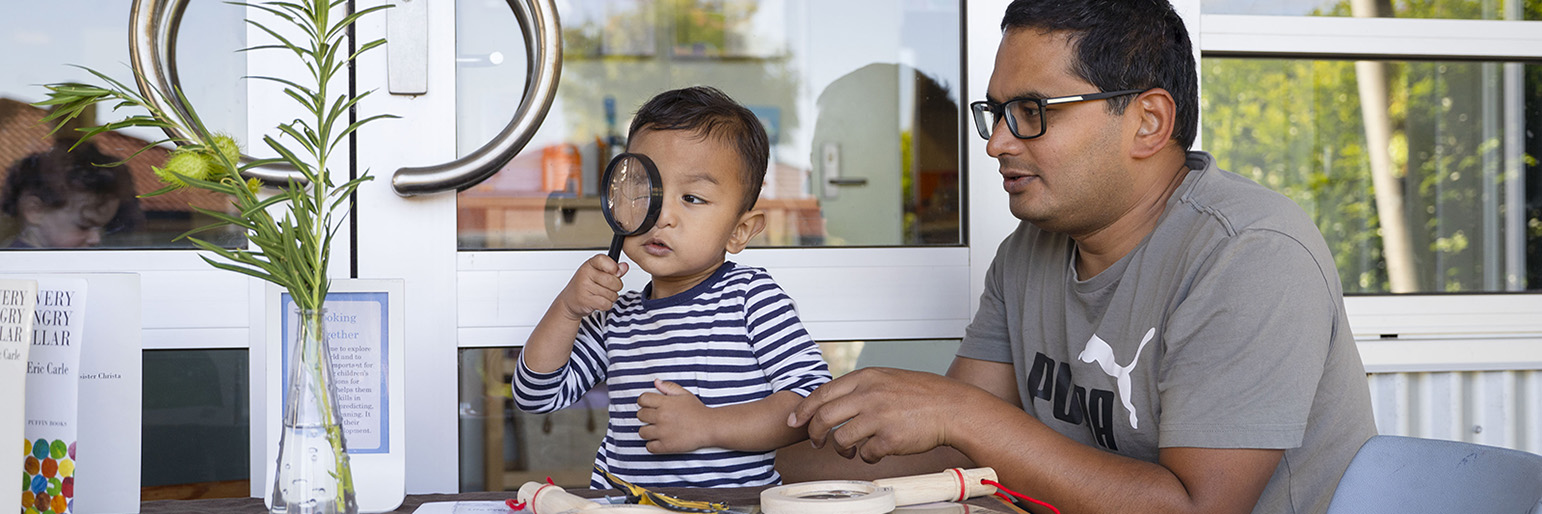Discovery table
Looking together
Talking about what you see builds your child’s vocabulary and helps them to connect to their world.

Activity
Make a table where you can display interesting items at playgroup. Provide magnifying glasses and containers for sorting and paper and pencils for drawing and recording. Encourage adults to support and talk to their child as they look at each item.
What you'll need
- A low table
- Natural or man-made items or collections of items, such as:
- shells
- twigs
- gumnuts/seed pods
- rocks
- honey dipper
- bones
- large buttons
- feathers
- leaves
- flowers
- insects
- mirrors
- magnifying glasses
- containers to sort items
- paper and pencils to record information
Words to use
- Shiny, slippery, rough/smooth, hard/soft, bumpy, texture, pattern
- Same/different
- Big/small, light/heavy
- Estimate, calculate, sort, classify
- Veins, stem, roots, leaves
- Alive/dead
- Enlarge, magnify
- Natural, man-made
Questions to discuss
- What is the most common?
- Which one can grow?
- Why do leaves change their colour?
Learning through play
Ways to develop numeracy through play
- Sort and group items. How many different ways can you sort the items, eg all the shells, all the gumnuts and all the pebbles or by colour or size? How many groups are there?
- Notice the attributes of items and use numerical language to describe what you see.
- Talk about patterns in the natural and man-made world.
- Make a pattern using items on the table.
- Count how many of each item you have.
- Make a chart or graph to display information about your collections.
Ways to develop literacy through play
- Talk about same and different.
- Look at each item and talk about what you see, feel, smell or hear.
- Record what children say about the objects.
- What can the item be used for? Try including some mystery items that children and families must guess what they are called and their purpose.
- Where would you find each item?
- Make up a story using the items on the table.
- Observe and draw the items on the table.
- Write a story about the objects for children.
- Use magnifying glasses to observe details and discuss.
- Use mirrors to create symmetry effects.
Extensions and variations to this activity
- Add a mortar and pestle with some herbs to crush. These herbs could then be used to garnish or flavour a healthy dish such as homemade pizza or veggie pasta.
- Make a seasonal table using seasonal items or fresh fruits and vegetables. You could extend this to talk about which season they most commonly grow and which fruits grow on trees, and which vegetables are found in the ground.
- Make treasure baskets of interesting items.
- Go for a walk to collect items – make a collage when you return.
- Take photos on your walk and make a book about what you saw.
- Paint on bark, sticks or pinecones.
- Make a sensory tray using various items.
- Add natural items to the playdough.
- Make a shape outline with chalk or masking tape on the ground – use items like gumnuts or bottle lids to make the shape.
- Try making a dinosaur world or other small world discovery table with various props.
- Hide items in a tub of rice or grain for children to find.
- Add natural items to the block area.
Supporting parent engagement in play
Play prompts:
Use words like smooth, rough, bumpy, prickly, heavy or light to describe what you see.
Ask questions, like:
- What can you see?
- What does it feel like?
- Where would you find it?
Parents or carers can:
- Comment on what their children are doing (say what they see).
- Talk in their home language.
- Use literacy and numeracy words (see words to use section above).
- Sit with their child and encourage them to explore and look at the objects.
- Talk about what they see, feel, hear, smell or taste.
You can help families by:
- Modelling what you want them to do.
- Talking to them about the focus of the activity and what children might be learning.
- Writing up words that go with the activity.
- Making suggestions on what families can do at home.
Related Great Start activities
Great Start activities are for parents and carers to do with their children.


